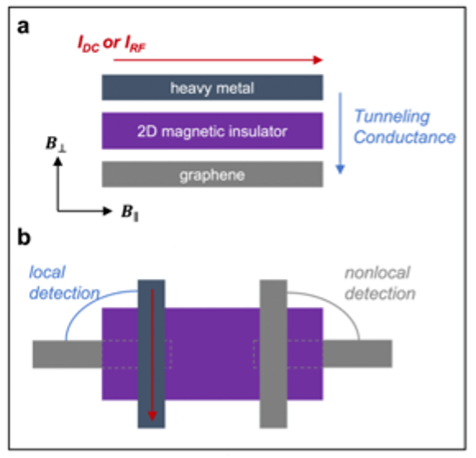In magnetic conductors, the passage of current yields an electric field in the transverse direction even without an external magnetic field – this is known as the anomalous Hall effect (AHE). This effect can act as a convenient probe of spin ordering, magnetic textures, spin-orbit coupling, and band topology in solids, and can be further exploited for developing spintronic devices. Recently, it has been shown that low-symmetry materials can exhibit a nonlinear version of the AHE, called the NLAHE, which allows for additional material functionalities with potential practical applications. Three common low-symmetry semimetals, WTe2, MoTe2, and TaIrTe4, have exhibited the NLAHE. The first goal of this project is to measure the spin accumulation and polarization direction on the surfaces and edges of these three materials using a unique approach combining spin transport techniques with van der Waals engineering in an inert atmosphere. With an applied current, there should be a net spin accumulation on the sample boundaries and by changing the direction of current injection or tuning with gates, the spin degrees of freedom can be manipulated. The spin polarization can also be different on the surfaces and the edges due to the thickness of the layers in the semimetals. By investigating the current- and gate-dependent accumulation and polarization in the sample, we may determine a new route for the electrical control of magnetism. Further, NLAHE in the semimetals can potentially be used as novel quantum sensors to detect radiofrequency, terahertz and infrared waves. For example, the Hall response of a NLAHE material coupled to a coplanar waveguide can be measured as broadband radiofrequency signal propagates in the waveguide. This would demonstrate the capability of NLAHE to detect broadband waves at radiofrequency. Success in these experiments will allow for exotic spintronic devices and sensors to be developed with functionalities unavailable with traditional materials, which with potential benefits to applications in the defense and security sectors.

Figure 1. A coplanar waveguide coupling with an RF source delivers microwaves across a broadband (Mo/W)Te2 device, with contacts to measure the response.
Related Content

Coherent magnon generation, magnon condensation, and quantum spin liquids via spin pumping in 2D magnets
Summary Developing hybrid quantum systems is essential to harnessing the complementary advantages of different quantum technology platforms. This necessitates the successful transfer of quantum information between platforms, which can be achieved, e.g., by harnessing magnons, or spin wave excitations, in magnetic materials. Decoherence due to uncontrolled coupling of qubits to the environment remains a fundamental […]
February 1, 2023

Mesoscopic systems as coherent control elements
Summary Mesoscopic systems provide a new tool for quantum systems design. In particular, they are enabling of robust quantum control. Here “mesoscopic system” refers to a connected network where each element, if studied alone, would be a quantum bit. The network is too big to be treated fully quantum mechanically. We do not have individual […]
September 1, 2016
Advanced microwave electronics enabling quantum technologies
Summary Superconducting quantum computers require quantum-limited measurements at microwave frequencies in order to implement error correction. Conventionally, this is accomplished using near quantum-limited Josephson Parametric Amplifiers (JPAs). The JPAs require bulky ferrite-based circulators that prevent on-chip integration of the amplifiers with the processor and take up the majority of space and cooling power in the […]
April 1, 2020
Line-Scanning optical coherence tomography system for in-vivo, non-invasive imaging of the cellular structure and blood perfusion of biological tissue
Summary Optical coherence tomography (OCT) is an optical imaging method that allows for in-vivo, non-invasive imaging of the structure and vasculature of biological tissue. Commercially available, clinical OCT systems utilize point-scanning method to acquire volumetric images over a large surface with typical frame rates of ~ 30 frames/ second. Since living biological tissue is constantly […]
August 27, 2019

